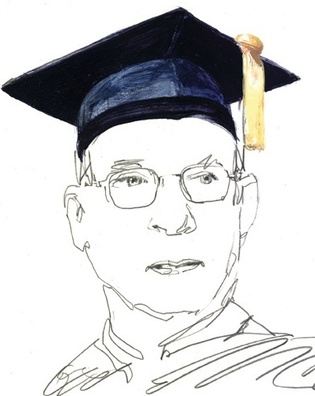 loading
loading
featuresOld hatThe evolution of your mortarboard Angus Trumble is senior curator of paintings and sculpture at the Yale Center for British Art. He is grateful to Lydia Shook ’07 for her valuable assistance in preparing this article. His own Master's mortarboard, nonelasticized, of pure new wool with silk trim, was created by the firm of R. W. Bredin & Son Limited, Academic, Legal and Civic Robe-Makers of Melbourne, Australia.  Alan BakerThe modern mortarboard began to take shape after the invention of the pileus quadratus, the square hat sported by Sir Thomas More in a portrait by Hans Holbein the Younger. View full imageOne of the small mysteries of commencement, for new graduates, proud parents and grandparents, honorees, and even at times for bewildered faculty, is: how on earth did we come to wear such preposterous ceremonial hats? From President Levin's splendid round hat, down through the various squashy velvet caps or bonnets worn by doctors and professors, to the humble graduands' mortarboards or trenchers (these days with their extraordinary array of unauthorized homemade adornments) -- in each case the answer is bound up with the long history of universities themselves. Their evolution, which may be traced in an antiquarian literature that is enormous, enjoyable, and entirely pointless, may prove intriguing not merely to milliners and connoisseurs of headgear, but also to anyone who has noticed, on that big day in May, the vigorous survival of this most enduring of all fashion accessories. Other forms of official hat are exceedingly old -- for example, crowns, full-bottomed wigs, miters, helmets, turbans, diadems, tiaras, and wimples -- but few if any have evolved with such inherent logic over the past thousand years as has the humble scholar's hat. Pious beginnings: 1000–1200 At the time of the French Revolution, when the new republic searched for potent symbols of civic virtue, that ancient Roman cap of liberty was somewhat imaginatively envisioned as "peaked" and repackaged for the modern age. Indeed, all peaked headgear shares this common intervening source and, of course, is now worn variously by naval officers, airline pilots, police, ticket collectors, and ice cream vendors. The baseball cap (somewhat bafflingly at times worn these days back to front) is therefore an essentially bona fide collateral descendant of the Roman pileus, although I am not quite sure how many wearers nowadays ruminate on this handy link to the noble concept of freedom. There is very little written evidence for the origins of the scholar's hat, because it was three or four centuries before universities started to generate a mass of written regulations and bylaws governing costume, but tomb sculpture and brass rubbings tell us what we need to know about the earliest forms of academic headgear. Even by these early dates, however, much discussion arose from the question whether it was not a presumption, or vanity, or dangerous solecism to wear a hood and cap, both at once. After all (as the antis argued), the hood or cowl was an ancient monastic accessory, stretching all the way back to St. Benedict (ca. 480-547 CE), and had long been worn over the head both liturgically and, at times, out of necessity for warmth. The fact that today we still wear caps and hoods (jauntily trailing them behind, over our academic gowns) demonstrates that this matter was firmly resolved in the negative. The practice of wearing hoods lined with silk or fur—not over the head, but dangling behind to signify by their different colors and textures which degree we have earned—arrived in universities comparatively recently, in the sixteenth century. Tasteful developments: 1200–1500 By this date the round hat had spawned numerous offspring, some with brims and some without, and in due course these migrated into the spheres of military, civic, even commercial life, from the beadle to the burgher and up to the prince. In a real sense, therefore, the topper, the bowler, the tall round chef's hat, even Pope Benedict's cozy, fur-lined camauro, all trace their ancestry back to the natty prototype of the pileus rotundus.
|
|